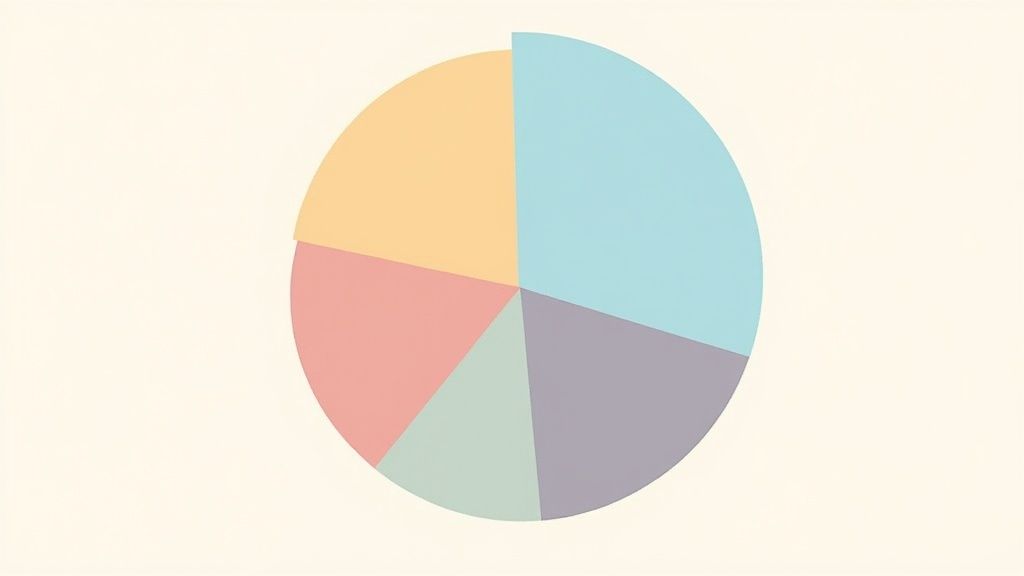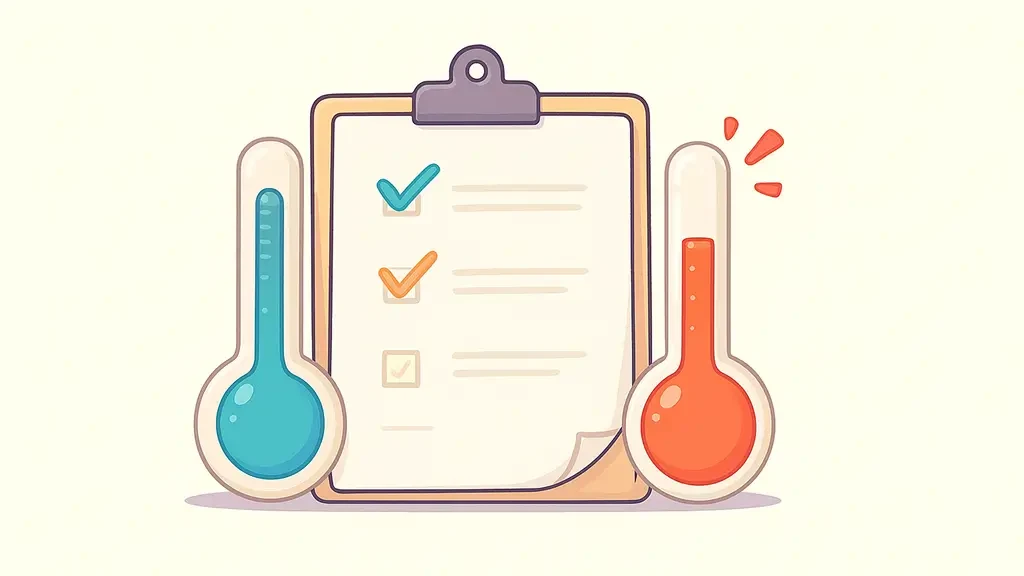How to Diversify Investment Portfolio: Top Strategies
Learn how to diversify investment portfolio effectively. Discover proven strategies to manage risk and grow your investments long-term.

To really diversify your investment portfolio, the core strategy is to spread your money across different asset classes, industries, and even geographical regions. This goes way beyond just owning a bunch of different stocks. It’s about building a portfolio with assets like bonds, real estate, and commodities that zig when others zag, ultimately reducing your overall risk.
What Investment Diversification Really Means

A lot of investors fall into a common trap. They think owning twenty different tech stocks makes them diversified. But if the tech sector takes a nosedive, their entire portfolio could be in trouble. That’s not diversification; it’s just concentrated betting.
True diversification is your first line of defense against the market's wild swings. It's a deliberate plan to protect your capital and aim for more consistent returns, no matter what one corner of the market is doing. Think of it less as owning ‘different things’ and more like assembling a team where every player has a unique, vital role.
The Power of Low Correlation
The secret sauce of effective diversification is correlation. It’s a simple metric that tells you how two assets move in relation to each other. When assets have a high positive correlation, they tend to rise and fall in tandem. But if they have a negative or low correlation, one might go up while the other goes down, smoothing out your portfolio’s journey.
For example, government bonds often hold their ground or even rally when stocks are falling during an economic rough patch. By holding both, the gains from your bonds can help cushion the blow from losses in your stocks. This balance is what creates a more stable, resilient portfolio over the long haul.
The real goal is to build a portfolio where your investments don't all move in lockstep. This is the bedrock principle for creating a portfolio that can weather inevitable market storms and protect your wealth for years to come.
Diversification Beyond Asset Classes
But great diversification doesn't just stop at mixing stocks and bonds. To really fortify your portfolio, you need to spread your investments across several layers.
Here are the key dimensions to consider:
- Across Industries: Holding stocks in different sectors—like healthcare, technology, consumer goods, and industrials—ensures that bad news for one industry doesn't torpedo all your equity holdings.
- Across Geographies: Investing in different countries and regions, such as Europe, Asia, and emerging markets, insulates you from a downturn in your home country's economy.
- Across Company Sizes: A healthy mix of large-cap (the established giants), mid-cap (the ambitious growers), and small-cap (the high-potential upstarts) stocks allows you to capture different types of growth opportunities.
By building a portfolio that is varied across all these dimensions, you create multiple, non-correlated streams of returns. If you want to dive deeper into putting this into practice, you can find excellent, detailed guides on how to diversify your stock portfolio for long-term growth. This layered approach is absolutely fundamental to managing risk and hitting your financial goals.
Define Your Personal Investment Strategy

Before you even think about buying a single stock or bond, you need a personal investment roadmap. Let's be clear: grabbing a generic template off the internet won't cut it. Your financial DNA is completely unique. A truly effective diversification strategy starts with an honest look in the mirror to figure out who you are as an investor.
It all boils down to two key factors: your risk tolerance and your investment horizon. These are the twin pillars that will support every single decision you make from here on out. Get them right, and they’ll guide your asset mix and stop you from making panicked, emotional moves when the market inevitably gets choppy.
Pinpoint Your True Risk Tolerance
Your risk tolerance isn't just a checkbox on a form. It's your gut reaction to seeing red in your portfolio. How would you really feel if your investments dropped 20% in a single month? Would you hit the panic button and sell everything, or would you see it as a chance to buy more at a discount?
You have to be brutally honest with yourself here. Think back to the 2022 market downturn—a whopping 96% of stocks in the S&P 500 fell at least 15%. Knowing how you would have handled that pressure is key to defining your investor profile.
- Conservative Investor: You're all about protecting your capital. Slow and steady growth is far more appealing to you than the thought of significant losses. Your portfolio will naturally lean toward lower-risk assets like government bonds.
- Moderate Investor: You're willing to ride out some market bumps in exchange for better long-term returns. You get that risk and reward go hand-in-hand and can sleep at night even if your portfolio takes a temporary hit.
- Aggressive Investor: High volatility doesn't scare you; it excites you. You see big market drops as a golden opportunity and have the stomach to handle the risk that comes with chasing maximum growth.
Knowing which of these you are is non-negotiable. It’s the compass that guides your asset allocation, ensuring your portfolio aligns with your emotional comfort zone. That alignment is what keeps you in the game for the long haul.
Define Your Investment Horizon
Next up is your investment horizon—how long you have until you need to start using this money. This is just as critical as your risk tolerance, if not more so. Why? Because your timeline directly dictates how much risk you can actually afford to take.
For example, a 25-year-old saving for retirement has decades to recover from any market downturns. They can afford to be more aggressive, loading up on stocks to maximize their growth potential over time.
On the flip side, someone just five years away from retirement is playing a completely different game. Their main goal has shifted from growth to preservation. A major loss at this stage could seriously derail their plans. Logically, their portfolio should be more conservative, with a heavier allocation to bonds and cash to cushion against volatility.
This personal context is the foundation of any smart diversification plan. It’s what turns a generic strategy into your strategy.
Building Your Core Portfolio with Smart Asset Allocation

Now that you've defined your personal strategy, it's time to lay the foundation. This is where we get into the nuts and bolts of building your portfolio through smart asset allocation—the art of blending different investment types to strike the right balance between risk and reward.
Think of it like cooking. The core ingredients are equities (stocks), fixed income (bonds), and alternatives. Each one plays a unique role, and the proportions you use will depend entirely on your risk tolerance and how long you plan to stay invested.
The Growth Engine: Equities
Equities, or stocks, are the growth engine of your portfolio. When you buy a stock, you’re buying a tiny piece of a company, giving you a claim on its future success. This is why stocks have historically delivered the highest long-term returns. But that potential comes with higher volatility.
A common rookie mistake is to assume all stocks are the same. A properly diversified equity sleeve should include a mix of flavors:
- Large-Cap U.S. Stocks: These are the stable, blue-chip giants like Apple or Johnson & Johnson. They form a solid, less volatile core for your portfolio.
- International Stocks: Spreading your bets into developed markets (like Europe and Japan) and emerging markets (like India and Brazil) lets you tap into global growth. It also helps insulate you if the U.S. economy hits a rough patch.
- Small-Cap Funds: Smaller companies pack more growth potential, though they also carry more risk. Pairing them with large-caps creates a powerful dynamic of stability and high-octane growth.
If you’re curious about how a company’s own actions signal its growth story, looking into its stock split history can offer some fascinating clues.
The Stabilizing Force: Fixed Income
Next up is fixed income, mostly bonds. Think of these as the shock absorbers for your portfolio. When you buy a bond, you're lending money to a government or company. In return, you get regular interest payments and your original investment back when the bond "matures."
Their main job? To provide a buffer when the stock market gets choppy. During a downturn, investors often run to the relative safety of bonds, which can cause bond prices to rise just as stock prices are falling. This inverse relationship is one of the key diversification benefits. A good mix might include ultra-safe government bonds alongside corporate bonds that offer a slightly higher yield.
A smart allocation isn't about eliminating risk—it's about managing it. Bonds are your portfolio's shock absorbers, smoothing out the ride during market volatility and providing a reliable income stream.
The Diversification Enhancers: Alternatives
Finally, we have alternatives. These are the assets that fall outside the traditional stock and bond buckets. Their real value comes from adding another layer of diversification, as their performance often has little to no connection to what the stock and bond markets are doing.
To get a clearer picture of how these asset classes work together, here’s a quick breakdown:
How Different Asset Classes Work in Your Portfolio
For instance, assets like real estate can provide rental income and property appreciation, while commodities like oil can help protect against inflation. And of course, there are precious metals.
By strategically combining these three core pillars—equities, fixed income, and alternatives—in a way that mirrors your personal goals, you create a portfolio built to weather market storms and grow steadily over the long haul.
Look Beyond Your Home Market with Global Investing

It’s easy to stick with what you know. Keeping all your investments within your home country feels safe and familiar, but this comfort comes with a hidden cost. This tendency, known as home country bias, ties your entire financial future to the economic ups and downs of a single nation. It's a classic case of putting all your eggs in one basket.
History is littered with cautionary tales for those who ignored global diversification. Just look at Japan in the late 1980s. After an unbelievable rally where Japanese stocks skyrocketed over 1,100%, investors were convinced the country's economic machine was unstoppable. What came next was a brutal crash and a "lost decade" that vaporized the wealth of anyone who was over-invested. You can get the full story on why international diversification is essential for portfolios.
True diversification means capturing growth wherever it happens, not just where you live. Expanding globally isn't just a defensive move; it's how you access a wider pool of opportunities and innovation.
Differentiating Between Developed and Emerging Markets
Once you decide to invest internationally, you'll find the world is split into two main camps. Understanding the difference is crucial for building a balanced global portfolio.
Developed Markets: These are the established, stable economies—think Western Europe, Canada, and Australia. They're characterized by mature industries, lower volatility, and strong financial regulations. Consider them the large-cap stocks of the global stage, providing a solid, reliable foundation for your international holdings.
Emerging Markets: This group includes faster-growing economies like Brazil, India, and China. They offer much higher growth potential but also come with more volatility and political risk. These markets can act as the growth engine of your international sleeve, much like small-cap stocks do for your domestic allocation.
A smart approach to diversifying your investment portfolio internationally involves a blend of both. For instance, you could anchor your international position with an ETF tracking a broad developed-world index, then add a smaller, targeted fund focused on emerging markets to capture that extra growth potential.
Practical Ways to Invest Globally
Getting international exposure into your portfolio is simpler than you might think. You don't need a foreign brokerage account or a degree in currency exchange.
Here are the most common tools at your disposal:
- International ETFs: Exchange-Traded Funds are a fantastic, low-cost way to buy a basket of stocks from a specific country, a whole region, or even the entire world (excluding your home market).
- Global Mutual Funds: These are actively managed funds where professionals do the research and select a portfolio of international stocks and bonds for you.
- American Depositary Receipts (ADRs): ADRs let you buy shares of individual foreign companies—like Sony or AstraZeneca—directly on U.S. stock exchanges, priced conveniently in U.S. dollars.
One last thing to keep in mind is currency risk. When you invest abroad, shifts in exchange rates can affect your returns. A stronger dollar can hurt your foreign returns, while a weaker dollar can give them a boost. While this adds a layer of complexity, it's also another form of diversification. For most long-term investors using diversified funds, these currency swings tend to even out over time and aren't something to lose sleep over.
How to Maintain and Rebalance Your Portfolio
Let's be honest: building a diversified portfolio is the fun part. The real work—and where most people drop the ball—is keeping it that way.
A diversified portfolio isn't a "set it and forget it" machine. It’s more like a high-performance engine that needs regular tune-ups. Over time, your winners will naturally grow into a bigger piece of the pie, which sounds great until you realize your carefully planned asset mix is totally out of whack. Your risk level silently creeps up.
This "portfolio drift" is normal, but letting it run wild completely undermines the point of diversifying in the first place. The fix is rebalancing—a disciplined process of periodically buying or selling assets to get your portfolio back to its original target. It’s the critical maintenance that keeps your long-term strategy on track.
Choosing Your Rebalancing Strategy
So, how often should you pop the hood and check things? There are a couple of popular methods, and the best one for you really comes down to your personality and how hands-on you want to be. There’s no single "right" answer, but whatever you choose, consistency is everything.
One common approach is calendar-based rebalancing. It’s simple and keeps you disciplined. You just pick a schedule—say, quarterly or annually—and stick to it. For most long-term investors, a once-a-year check-in is plenty. It’s enough to catch major drift without tempting you to over-trade.
The other main style is threshold-based rebalancing. Here, you set specific tolerance bands for each asset class. For example, you might decide to act whenever any single asset class moves more than 5% from its target. If you aimed for 50% in U.S. stocks and a hot market pushes that slice to 56%, a rebalance is triggered.
Rebalancing feels completely counterintuitive. You’re forced to sell what's working and buy what’s lagging. But that’s the magic. This discipline systematically enforces the "buy low, sell high" mantra, taking emotion out of the driver's seat.
The Mechanics of Smart Rebalancing
Okay, so you’ve spotted some drift. Now what? You can’t just blindly hit the "sell" button without thinking about the real-world consequences—especially taxes. Selling your high-flyers in a regular brokerage account will trigger capital gains taxes, which can be a real drag on your returns.
Here are a few smarter ways to get things back in line:
- Use New Cash: This is the easiest, most tax-friendly method. If you're regularly adding money to your portfolio, just direct new contributions to your underweight asset classes. No selling, no taxes. Simple.
- Rebalance Inside Tax-Advantaged Accounts: Do most of your rebalancing inside accounts like a 401(k) or an IRA. Since there are no tax hits for buying and selling within these wrappers, you can trim your winners and bulk up your losers without a tax bill.
- Strategic Gifting or Spending: Planning to donate to charity? Consider giving appreciated shares directly instead of cash. You get your portfolio back in balance, and you may get a nice tax deduction without ever having to sell and pay capital gains.
A good investment portfolio tracker can be a huge help here. These tools consolidate everything in one spot, making it painfully obvious when your allocations have drifted. And don’t forget that corporate actions can also shift your holdings; knowing a company's stock split history, for example, is part of managing individual positions.
Finally, remember that some events demand more than just a simple tune-up. Big life changes—a new job, marriage, getting close to retirement—should always trigger a full portfolio review. These moments often shift your goals and risk tolerance, meaning your entire asset allocation might need an overhaul, not just a minor rebalance.
Your Diversification Questions, Answered
Once you get past the theory, the real questions start popping up. Let's tackle some of the most common ones I hear from investors who are just starting to put their diversification plan into action.
How Much Money Do I Need to Start Diversifying?
There's a persistent myth that you need a fortune to build a properly diversified portfolio. That might have been true decades ago, but it’s completely false today. The big game-changer has been the rise of low-cost Exchange-Traded Funds (ETFs) and mutual funds.
Honestly, you can get started with very little capital. With a single purchase of a broad-market ETF, you can instantly own tiny slices of hundreds, sometimes thousands, of different companies. You could buy one ETF for U.S. stocks, another for international ones, and a third for bonds. Just like that, with only three trades, you've built a simple but genuinely diversified foundation.
How Often Should I Really Rebalance My Portfolio?
There’s no magic number here, but what truly matters is consistency. For most people with a long-term outlook, checking in and rebalancing your portfolio once a year is a solid, manageable schedule. It's frequent enough to catch any major drifts before they throw your risk profile out of whack but infrequent enough to keep you from constantly tinkering and racking up trading fees.
Another popular and effective method is to rebalance based on thresholds. For instance, you could set a rule to only take action when an asset class wanders more than 5% from its target. This approach is more hands-off but still forces you to act when it really counts.
The most important part of rebalancing isn't the when, but the discipline to actually do it. It’s a system for selling high and buying low—the exact opposite of what our emotions scream at us to do in a volatile market.
Do Cryptocurrencies Have a Place in a Diversified Portfolio?
This is the big question on everyone's mind, and the answer isn't simple. Assets like Bitcoin are wildly volatile and have a very short track record compared to traditional workhorses like stocks and bonds. They are, without a doubt, a highly speculative play.
If you have a high tolerance for risk and a long time horizon, you might consider a very small allocation—think 1% to 2% of your total portfolio, max. Treat it like a lottery ticket, not a core holding. It has to be money you are fully prepared to lose without it derailing your long-term financial goals. For more established assets, you can find a wealth of data to inform your decisions, like the stock split history for major companies like Apple, which gives you a clearer picture of a traditional asset's journey.
Ready to stop guessing and start optimizing? PinkLion gives you the professional-grade tools to track, analyze, and stress-test your entire portfolio in one place. Consolidate your accounts and get AI-powered insights to build a smarter, more resilient investment strategy. Start for free and take control of your financial future.
Article created using Outrank
